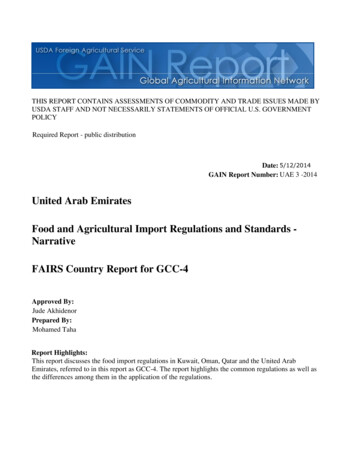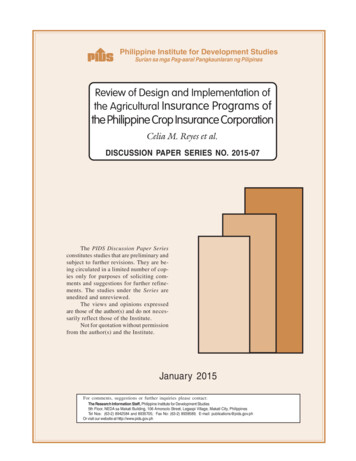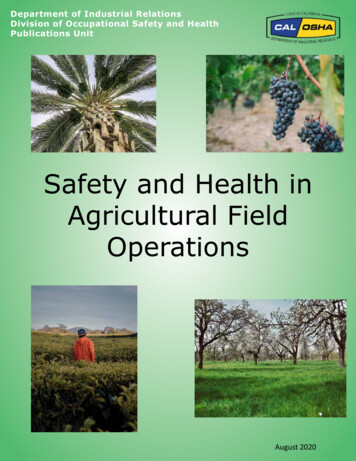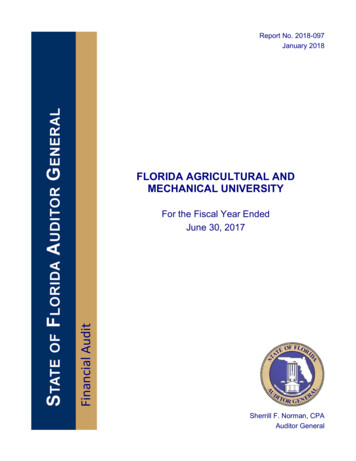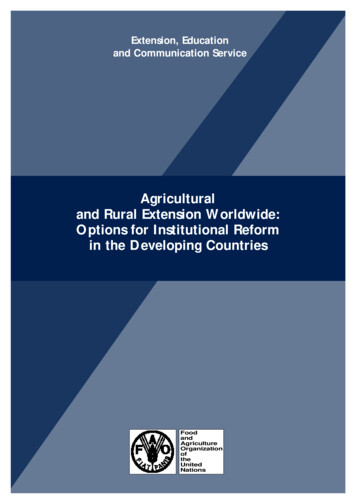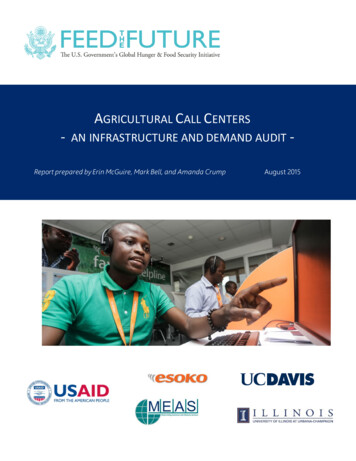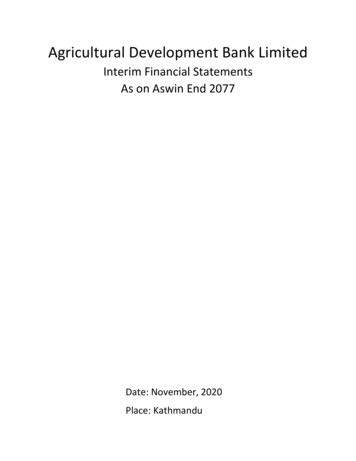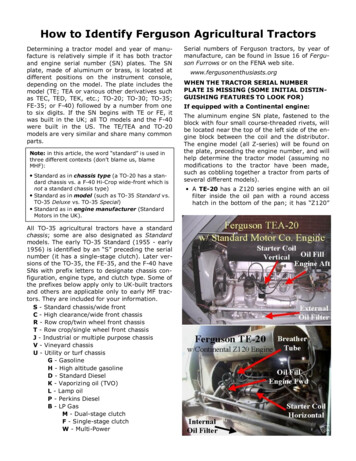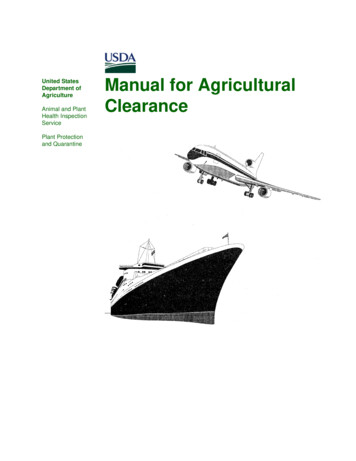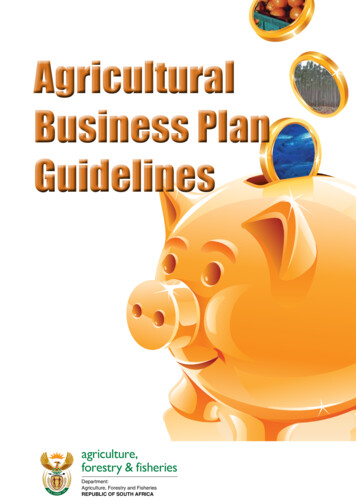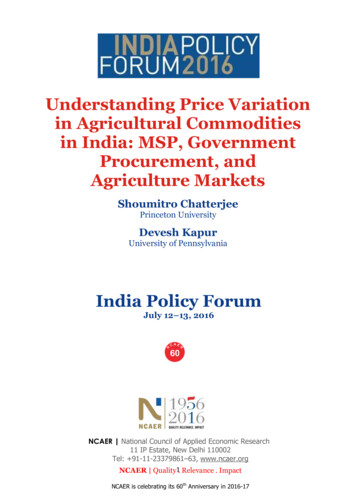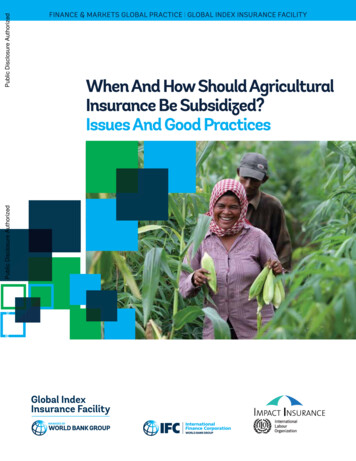
Transcription
When And How Should AgriculturalInsurance Be Subsidized?Issues And Good PracticesPublic Disclosure AuthorizedPublic Disclosure AuthorizedPublic Disclosure AuthorizedPublic Disclosure AuthorizedFINANCE & MARKETS GLOBAL PRACTICE GLOBAL INDEX INSURANCE FACILITYGlobal IndexInsurance FacilityMANAGED BY
Rights and PermissionsThis work is available under the Creative Commons CC BY-NC-ND 3.0 IGO license. Copyright 2017 International LabourOrganization (“ILO”) and International Finance Corporation (“IFC”). All rights reserved. This is a joint publication of ILO andIFC.The material in this work is copyrighted. Copying and/or transmitting portions or all of this work without permissionmay be a violation of applicable law. IFC does not guarantee the accuracy, reliability or completeness of the contentincluded in this work, or for the conclusions or judgments described herein, and accepts no responsibility or liability forany omissions or errors (including, without limitation, typographical errors and technical errors) in the contentwhatsoever or for reliance thereon.The contents of this work are intended for general informational purposes only and are not intended to constitute legal,securities, or investment advice, an opinion regarding the appropriateness of any investment, or a solicitation of any type.IFC or its affiliates may have an investment in, provide other advice or services to, or otherwise have a financial interest in,certain of the companies and parties (including named herein).All other queries on rights and licenses, including subsidiary rights, should be addressed to IFC’s CorporateRelations Department, 2121 Pennsylvania Avenue, N.W., Washington, D.C. 20433 and ILO Publications (Rights andPermissions), International Labour Office, CH-1211 Geneva 22, Switzerland or by email: pubdroit@ilo.org.International Finance Corporation is an international organization established by Articles of Agreement among itsmember countries, and a member of the World Bank Group.All names, logos and trademarks in this publication are the property of either the IFC or the World Bank Group, orproperty of the International Labor Organization. Unless expressly stated otherwise, and you may not use any of suchmaterials for any purpose without express written consent from the trademark owner. Additionally, “InternationalFinance Corporation” and “IFC” are registered trademarks of IFC and are protected under international law.Publications of the International Labour Office enjoy copyright under Protocol 2 of the Universal CopyrightConvention. Nevertheless, short excerpts from them may be reproduced without authorization, on condition that thesource is indicated.Photo Credits: World Bank Photo Library and ShutterstockWHEN AND HOW SHOULD AGRICULTURAL INSURANCE BE SUBSIDIZED? ISSUES AND GOOD PRACTICES
Peter Hazell Independent ResearcherRachel Sberro-Kessler & Panos Varangis Finance & Markets Global Practice World Bank Group
Table of ContentsAcknowledgements.IIIExecutive Summary. V1. Introduction. 12. Existing Types of Levels of Subsidies for Agricultural Insurance.33. Reasons for Subsidizing Agricultural Insurance.7Subsidies to Correct Failures and Externalities in Insurance Markets.7Subsidies to Achieve Broader Social and Political Goals. 94. Challenges in Subsidizing Agricultural Insurance. 115. Does Subsidizing Agricultural Insurance Pay?.156. Principles And Good Practices in the Design of Subsidies for AgriculturalInsurance.21Guidelines for Subsidizing Insurance for Commercial Farmers.22Guidelines for Subsidizing Agricultural Insurance for Poor Farmers.24Guidelines for Subsidizing Insurance to Improve or Replace DisasterAssistance. 277. Conclusions. 35References. 39Annex: The Choice Between Subsidizing an Insurer’s Costs Versus ProvidingSubsidized Reinsurance. 43LIST OF BOXESBox 1: Ex Ante Cost-Benefit Evaluation of an Insurance Program inBangladesh.16Box 2: The R4 Risk Resilience Initiative in Ethiopia. 26Box 3: Early Recovery Vouchers (ERVOs). 28Box 4: Seguro Agricola Catastrófico (SAC) in Peru. 30Box 5: The CADENA Program in Mexico. 33TABLE OF CONTENTSI
Box 6: Pros and Cons of Premiums Subsidies and Public Reinsuranceof Extreme Risk Layers. 44Box 7: Some Examples of Public Reinsurance Arrangements Verses DirectSubsidies for Risk Loading Costs. 45LIST OF FIGURESFigure 1: Illustrative Comparison of Disaster Relief and 50 PercentSubsidized AYII Across Years With Different Levels of Shocks. 17Figure 2: Overlap Between Agricultural Insurance and Disaster Assistance.22Figure 3: Government of Mongolia is “Double Exposed” to Extreme Risks.46Figure 4: Agricultural Insurance Program in Kenya.47LIST OF TABLESTable 1: Producer Claim Ratios for Seven Countries.5Table 2: Cost to Government of Transferring Income to Farmers ThroughSubsidized Crop Insurance Programs in Four Countries .18WHEN AND HOW SHOULD AGRICULTURAL INSURANCE BE SUBSIDIZED? ISSUES AND GOOD PRACTICESII
AcknowledgementsThe authors are grateful to Joe Glauber, Ruth Hill, and Oliver Mahul forreviewing this paper. The authors also thank Carlos Arce, Ulrich Hess, MichalMatul, Roy Parizat, and Pranav Prashad for helpful comments on earlierdrafts. Appreciation is also extended to Pavis Devahasadin and Joost Tijdinkfor coordinating the production process and Aichin Lim Jones for design andlayout support.Global Index Insurance FacilityThe Global Index Insurance Facility (GIIF) is a multidonor program thatsupports the development and growth of local markets for indexed/catastrophicinsurance in developing countries, primarily in Sub-Saharan Africa, LatinAmerica and the Caribbean, and Asia Pacific. Funded by the European Union,Japan, and the Netherlands, the Global Index Insurance Facility is managed bythe World Bank Group, as part of the Finance & Markets Global Practice.Impact Insurance FacilityHoused at the International Labour Organization, the Impact Insurance Facilityenables the insurance industry, governments, and their partners to realize thepotential of insurance for social and economic development. The Facilitywas launched in 2008 with generous support from the Bill & Melinda GatesFoundation, and has received subsequent funding from several donors.ACKNOWLEDGEMENTSIII
WHEN AND HOW SHOULD AGRICULTURAL INSURANCE BE SUBSIDIZED? ISSUES AND GOOD PRACTICESIV
Executive SummaryAgricultural insurance is subsidized in many countries, at a global cost togovernments of well over 20 billion each year. There are many reasons behindthese subsidies, some having to do with market failures and externalities thatconstrain the development of privately provided and unsubsidized insurance,and some having more overt political and social objectives such as helpingspecific segments of poorer farmers access insurance, protecting agriculturallending institutions, reducing the need for disaster assistance payments, orsimply as a politically acceptable means of supporting farm incomes. Very littleis really known about the effectiveness of insurance subsidies in achieving theirintended purposes, or whether the impacts they generate justify their costs, andthere is a real need for more evaluations and impact assessments of subsidizedagricultural insurance programs. Much more is known about the challenges thatcan all too easily undermine the benefits from agricultural insurance subsidies.These include well known challenges with the design and operation ofagricultural insurance programs themselves, poorly designed subsidies added tothose programs, plus political dynamics that make it hard to terminate or containthe amount of the subsidy. Poorly designed subsidies can also inadvertentlycreate disincentive problems that lead to significant economic costs andinefficiencies, and in some circumstances, to environmental degradation. Toavoid these problems, any insurance subsidy needs to be carefully designedto be “smart”, in the sense that it is cost effective in achieving its underlyingpurpose, minimizes disincentive problems, and does not become a growingfinancial burden on the government. This paper discusses these issues in detailand draws upon available literature and case study experiences to proposesome good practice guidelines for the design and implementation of subsidizedagricultural insurance.EXECUTIVE SUMMARYV
WHEN AND HOW SHOULD AGRICULTURAL INSURANCE BE SUBSIDIZED? ISSUES AND GOOD PRACTICESVI
1. IntroductionAgricultural insurance, defined here to include crop and livestock insurance,is an instrument of choice in many countries for helping farmers and ruralcommunities cope with risk. Some insurance is private, sold by insurancecompanies to farmers on a purely commercial, non-subsidized basis, but, as willbe seen, most agricultural insurance is provided on a subsidized basis as partof government efforts to further development, social or political goals. Manybillions of dollars are spent each year on premium subsidies and other formsof financial support for agricultural insurance. A World Bank study estimatedthat in 2007, the total global cost to governments was about 20 billion (Mahuland Stutley, 2010). However, that figure seems low today given that just threecountries - China, India and the US, are together spending about 17.7 billioneach year. To put this in perspective, total OECD bilateral and multilateralsupport for agriculture in the developing world was about 11 billion in 20141.This paper explores the reasons why governments and donors subsidizeagricultural insurance, and asks a) is this a worthwhile way to spend publicmoney, and b) if insurance must be subsidized are there smarter ways of doingit that can achieve the same objectives, but at lower cost, and which avoidsome of the economic and institutional pitfalls that have plagued subsidizedagricultural insurance in the past.The paper is structured as follows. The next section reviews existing typesand levels of subsidies for agricultural insurance, both globally and for thedeveloping world. Section 3 reviews the various arguments that have beenoffered for subsidizing agricultural insurance, while section 4 discusses someof the key challenges that have arisen when insurance subsidies are poorlydesigned. Section 5 seeks to balance the benefits and costs of subsidizedagricultural insurance, and asks whether this has proven to be a worthwhileway of spending public funds. Given that many governments and donorsseem likely to continue to subsidize agricultural insurance, section 6 presentsa set of guiding principles and best practices to be used in their design andimplementation. Finally, section 7 concludes.Calculated from OECD DAC data: 016.pdf11. INTRODUCTION1
WHEN AND HOW SHOULD AGRICULTURAL INSURANCE BE SUBSIDIZED? ISSUES AND GOOD PRACTICES2
2. Existing Types and Levelsof Subsidies for AgriculturalInsuranceThe extent of agricultural insurance around the world was assessed in 2008 byresearchers at the World Bank. They estimated that 104 countries had someform of agricultural insurance in 2007, and that the total premium collectedthat year, including premium subsidies, was an impressive 20 billion (Mahuland Stutley, 2010). More detailed insights were obtained for 65 countries thatcompleted a questionnaire. The total premium collected in these countries in2008 was 15.1 billion. Of this amount, 86% was collected in high-incomecountries and only 0.03% was collected in low income countries, showing thatagricultural insurance is largely the preserve of the rich.Globally, about 90% of the total premium collected was for crop insurance and10% was for livestock insurance. Multiple Peril Crop Insurance (MPCI) wasavailable in two thirds of the countries, but was most popular in the middleincome countries. Named peril insurance was available in 69% of the countries,including half of the low-income countries. Area-yield insurance was availablein 15% of the countries, and weather index insurance was available in 22% ofthe countries, but mostly on a pilot basis.There has been significant expansion of agricultural insurance since 2008,especially of index based schemes in the US, India and China. Based on arecent review of documented index-based agricultural insurance programs inthe developing world, Hess and Hazell (2016) estimate that about 198 millionfarmers were insured in 2014, divided into approximately 650,000 in Africa,3.3 million in Latin America and the Caribbean, and about 194.2 million inAsia - of which 160 million were in China and 33.2 million in India. Given thatthere are about 550 million farms in the developing world (Lowder et al., 2014),it would seem that about one third of them now have some kind of agriculturalindex insurance. Clearly IBI has achieved scale.Yet despite these impressive numbers, market penetration remains small, evenin rich countries. In 2008, the total insurance premium collected (includingsubsidies) in the World Bank survey amounted to 0.9% of agricultural GDP,ranging from virtually zero in low-income countries to 2.3% in high-incomecountries (Mahul and Stutley 2010). One reason for this low coverage is thatonly a small part of the crop area and livestock population is insured. Another2. EXISTING TYPES AND LEVELS OF SUBSIDIES FOR AGRICULTURAL INSURANCE3
reason is that most programs only insure farmersagainst losses for specific crops or livestock, or payto replace purchased inputs or repay credit wheninsured losses occur. As such, the insured coveragetypically represents just a small fraction of afarmer’s total exposure to farm income and assetrisks.The majority of agricultural insurance programsare subsidized. Mahul and Stutley (2010) foundthat of the 65 countries that completed theirquestionnaire, one third had an unsubsidized cropor livestock insurance program. However, theunsubsidized programs are at a much smaller scale,and of the total premium collected from farmers inall 65 countries, only 15% was not matched by apremium subsidy (Mahul and Stutley, 2010, Tables3.23 and 3.24). The premium subsidies addedup to 6.6 billion, or 44% of the total premiumcollected. In addition, governments spent at leastanother 1.5 billion subsidizing administrative andoperational costs, and another 2.2 billion in theform of direct payments to insurers to help settleclaims. When these additional costs are added in,the average subsidy equivalent increases from 44%to 68%. The cost of insurance to governments hassince increased, largely because they have beenscaled up. For example, each year the Chinesegovernment now spends about 6 billion annually2on its insurance programs, the Indian governmentspends 2.75 billion3, and the US government isprogrammed to spend 9 billion annually over thenext 10 years4.Of all the IBI-like programs Hess, Hazell and Kuhn(2016) reviewed, the only programs with low orno subsidies were for insurance coverage providedwithin contract farming arrangements, which alsoincluded access to modern inputs, markets andcredit. Most other forms of IBI were subsidized:the average subsidy was 37% for input supplierschemes, 40% for farmer group schemes, 63% forcredit-linked schemes, 67% for direct insurance,and 80% for safety net insurance schemes.The producer claims ratio (PCR), calculated asI/P, where I is total claim payments and P is totalpremium collected from farmers net of any subsidy,is a direct measure of how much the farmer getsback in claim payments on average for each dollarof premium he/she pays. Hazell (1992) reportedPCRs for 7 country programs in the 1980s, rangingfrom 0.99 in Japan to 5.11 in India. This meant thatin India, for example, farmers on average receivedpayments worth 5.11 for every dollar of premiumthey paid. Remarkably, the insurance still had tobe made compulsory for farmers who borrowedcredit. In their update, Mahul and Stutley (2010)found that PCRs were lower during 2003-07, as, forexample, in the comparative numbers reported inTable 1. Yet still most farmers are getting back farmore than they pay on average (e.g., Indian farmersare getting back 3.36 for every dollar of premiumthey pay) and still many farmers are choosing not topurchase insurance.2014, source: CIRC, Chinese Regulatory Authority.Proposed budget for the new PMFBY scheme, comprehensive agricultural insurance especially for farmers with loans. bima-crop-insurance-scheme/.4Joe Glaubner, personal communication.23WHEN AND HOW SHOULD AGRICULTURAL INSURANCE BE SUBSIDIZED? ISSUES AND GOOD PRACTICES4
Table 1: Producer Claim Ratios for Seven CountriesCountryProducer Loss RatioBrazil1975-814.292004-071.19Costa : Calculated as total claim payments divided by total premium paid by farmers.Source: Hazell (1992) and author’s calculations based on data in Mahul and Stutley (2010).2. EXISTING TYPES AND LEVELS OF SUBSIDIES FOR AGRICULTURAL INSURANCE5
WHEN AND HOW SHOULD AGRICULTURAL INSURANCE BE SUBSIDIZED? ISSUES AND GOOD PRACTICES6
3. Reasons for SubsidizingAgricultural InsuranceThere are many reasons why governments and donors subsidize agriculturalinsurance. Some are based on narrow economic arguments like market failures,externalities and establishment problems that constrain the development ofprivate sector insurance and insurance markets, or which systematically excludecertain segments of farmers from insurance, such as poor or women farmers,or farmers in high risk regions. Many governments also subsidize agriculturalinsurance as a way of achieving other social and political goals in additionto risk management, where insurance subsidies are seen as a more politicallyacceptable or cost efficient way of achieving those goals than other availablepolicies. Despite their varying purposes, insurance subsidies all seek to reducerisk exposure for farmers, whether against catastrophic natural disasters ormore normal agricultural production risks. Most often, subsidies also help scaleup the demand for agricultural insur
money, and b) if insurance must be subsidized are there smarter ways of doing it that can achieve the same objectives, but at lower cost, and which avoid some of the economic and institutional pitfalls that have plagued subsidized agricultural insurance in the past. The paper is structured as follows. The next section reviews existing types
